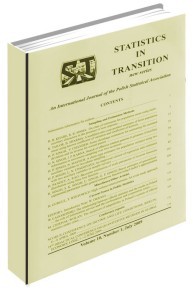Percentile-Adjusted Estimation of Poverty Indicators for Domains Under Outlier Contamination
Percentile-Adjusted Estimation of Poverty Indicators for Domains Under Outlier Contamination
Author(s): Ari Veijanen, Risto LehtonenSubject(s): Economy
Published by: Główny Urząd Statystyczny
Keywords: small area estimation;poverty indicator;income data;bias correction;auxiliary information;mixed model;prediction
Summary/Abstract: Traditional estimation of poverty and inequality indicators, such as the Gini coefficient, for regions does not currently use auxiliary information or models fitted to income survey data. A predictor-type estimator constructed from ordinary mixed model predictions is not necessarily useful, as the predictions have too small spread for estimation of income statistics. Ordinary bias corrections are aimed at correcting the expectation of predictions, but poverty indicators would not be affected at all by a correction involving multiplication of predictions. We need a method improving the shape of the distribution of predictions, as poverty indicators describe differences of income between people. We therefore introduce a transformation bringing the percentiles of transformed predictions closer to the percentiles of sample values. The experiments show that the transformation results in smaller MSE of a predictor. If unit-level data from population are not available, the marginal domain frequencies of qualitative auxiliary variables can be successfully incorporated into a new calibration-based predictor-type estimator. The results are based on design-based simulation experiments where we use a population generated from an EU-wide income survey. The study is a part of the AMELI project funded by the European Union under the Seventh Framework Programme for research and technological development (FP7).
Journal: Statistics in Transition. New Series
- Issue Year: 12/2011
- Issue No: 2
- Page Range: 345-356
- Page Count: 12
- Language: English

